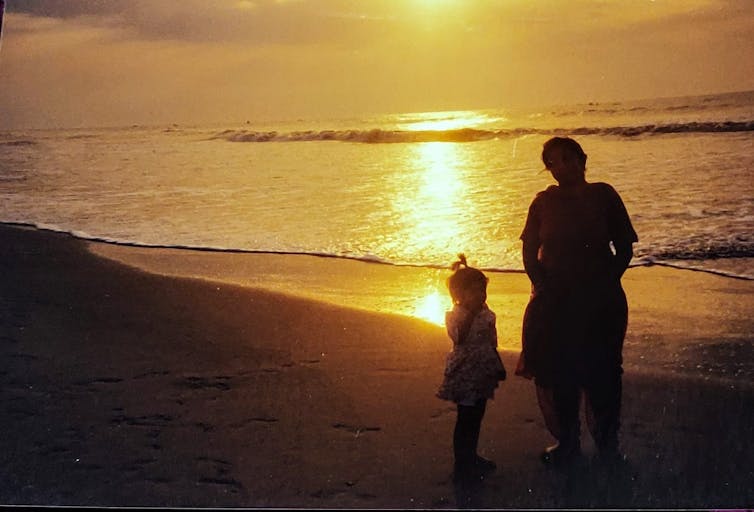In the midst of deep grief, a scholar writes how Hindu rituals taught her how to let go
Hindu philosophy believes the soul to be immortal. Death is considered to be the end of only physical incarnation, as the soul continues its journey of multiple births until its final liberation.

Cultures have built elaborate rituals to help humans process the grief of losing someone.
Rituals can hold the core beliefs of a culture and provide a sense of control in an otherwise helpless situation. I came to understand this when I lost my mother last year and participated in the primary Hindu rituals of death and grief.
The cultural practices and experiences helped me find meaning in my loss.
Body and soul
Many Eastern religions do not bury their dead; instead, they cremate them. Most Hindus consider this to be the final sacrifice of a person.
The Sanskrit word for death, “dehanta,” means “the end of body” but not the end of life. One of the central tenets of Hindu philosophy is the distinction between a body and a soul. Hindus believe that the body is a temporary vessel for an immortal soul in the mortal realm. When we die, our physical body perishes but our soul lives on.
The soul continues its journey of birth, death and rebirth, in perpetuity until a final liberation. This is at the heart of the philosophy of detachment and learning to let go of desires.
Scholars of Indian philosophy have argued about the importance of cultivating detachment in the Hindu way of life. An ultimate test of detachment is the acceptance of death.
Hindus believe that the soul of the deceased stays attached to its body even after its demise, and by cremating the body, it can be set free. As a final act, a close family member forcefully strikes the burning corpse’s skull with a stick as if to crack it open and release the soul.
To fully liberate the soul of its mortal attachments, the ashes and remaining bone fragments of the deceased are then dispersed in a river or ocean, usually at a historically holy place, like the banks of the River Ganges.
Knowledge within rituals
Someone from a different tradition might wonder why a ritual should ask mourners to destroy the body of their loved ones and dispose of their remains when one should be caring for all that remains of the dead?
As shocking as it was, it forced me to understand that the burning corpse is only a body, not my mother, and I have no connection left to the body. My Ph.D. studies in cognitive sciences, a field that seeks to understand how our behavior and thinking are influenced by interactions between brain, body, environment and culture, made me look beyond the rituals. It made me understand their deeper relevance and question my experiences.
Rituals can help us understand concepts that are otherwise elusive to grasp. For example, scholar Nicole Boivin describes the importance of physical doorways in rituals of social transformation, like marriage, in some cultures. The experience of moving through doorways evokes transition and creates an understanding of change.

Through the rituals, ideas that were abstract until then, such as detachment, became accessible to me.
The concept of detachment to the physical body is embodied in the Hindu death rituals. Cremation creates an experience that represents the end of the deceased’s physical body. Further, immersing ashes in a river symbolizes the final detachment with the physical body as flowing water takes the remains away from the mortal world.
[Deep knowledge, daily. Sign up for The Conversation’s newsletter.]
Dealing with the death of a loved one can be incredibly painful, and it also confronts one with the specter of mortality. The ritual of liberating the soul of the dead from its attachments is also a reminder to those left behind to let go of the attachment to the dead.
For it is the living who must learn to let go of the attachment to the dead, not the long-gone soul. Cultural rituals can widen one’s views when it is difficult to see past the grief.
Standing at a place where millions before me had come and gone, where my ancestors performed their rites, I let go of my mother’s final remains in the holy waters of the river Ganges.
Watching them float away with the waves of the ancient river helped me recognize that this was not the end but a small fragment in the bigger circle of life.
As the Hindu text, the “Bhagavad Gita” – The Song of God – says of the soul,
It is not born, it does not die;
Having been, it will never not be.
Unborn, eternal, constant and primordial;
It is not killed, when the body is killed.
Ketika Garg does not work for, consult, own shares in or receive funding from any company or organisation that would benefit from this article, and has disclosed no relevant affiliations beyond their academic appointment.
Read These Next
From truce in the trenches to cocktails at the consulate: How Christmas diplomacy seeks to exploit s
World leaders like to talk up peace at Christmastime. But alongside the tales of seasonal breaks in…
How to reduce gift-giving stress with your kids – a child psychologist’s tips for making magic and a
Depending on family circumstances and a child’s personality type, gift giving runs the gamut of fun…
People are getting their news from AI – and it’s altering their views
Even when information is factually accurate, how it’s presented can introduce subtle biases. As large…






